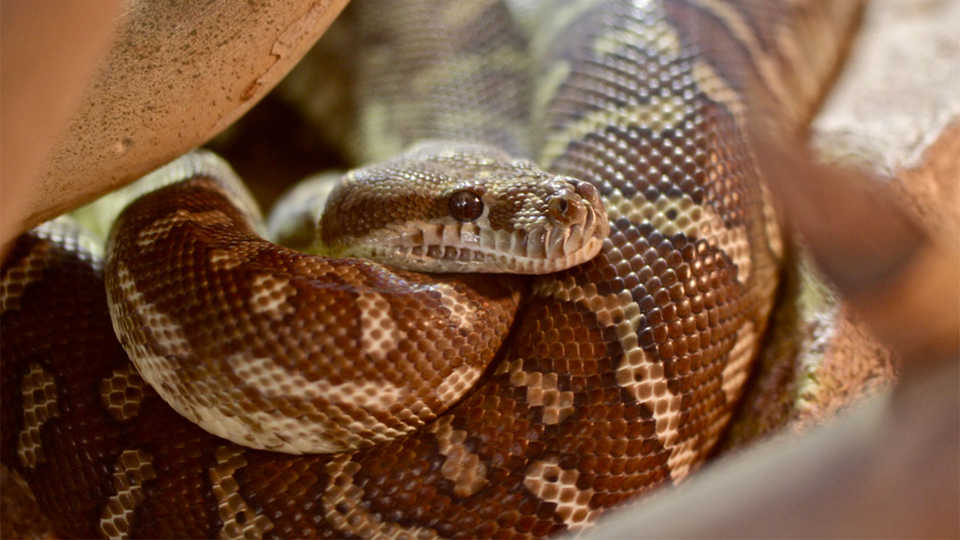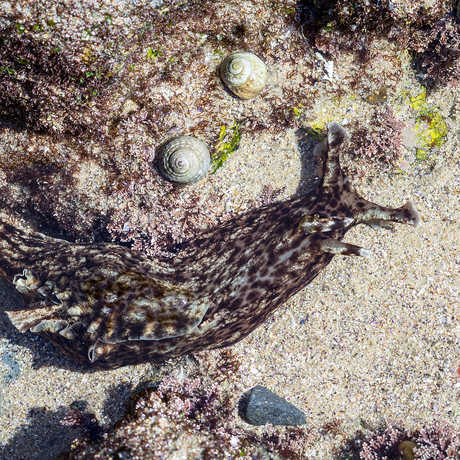
© Ron DeCloux
Explore the rainforest and aquarium while you learn about reptiles and discover some adaptations that help snakes and lizards survive in their environments.
Through this scavenger hunt, students will:
- observe examples of reptiles found throughout the Academy.
- practice connecting the physical characteristics or behaviors of reptiles with their apparent functions.
- Reptiles Scavenger Hunt (one sheet per student)
- pencils
Important Safety Note: The animals featured on the front page of this scavenger hunt can be found in the Rainforest exhibit. On occasion, visitors have accidentally dropped personal items into the open-top aquarium at the ground level of the Rainforest, only to be swallowed by our catfish! Therefore, the front page of this activity was designed for students to complete without a pen or pencil. For the safety of the live animals on exhibit, we ask that personal belongings be stowed away as you wander up the ramp.
- Print out the Reptiles Scavenger Hunt for each student.
- Go over the scavenger hunt questions with your adult chaperones ahead of time and make sure they are familiar with the activity and vocabulary.
- Review the major types of reptiles, including snakes, lizards, tortoises, turtles, and alligators. There are over 9,000 different kinds of reptiles, and they are very diverse in where they live, what they look like, how they move and what they eat.
- Go over the questions on the scavenger hunt with your students and make sure they understand what they will be doing.
- Divide students into their chaperone groups. You may wish for groups to start in different areas of the Academy. This activity is designed to start in the Rainforest, and then move directly to the Flooded Amazon, Water Planet, and Swamp. However, the hunt can be completed in any order.
- Allow time for students to explore, observe, and answer the questions on the scavenger hunt.
Ask students to share examples of the different structures and the functions they found that help reptiles survive. If students want to research organisms more in depth, they can visit the Naturalist Center on Level 3, which features books,computers, and helpful staff
adaptation: a structure or behavior that increases an organism’s chance of surviving and reproducing in a particular environment
reptile: any cold-blooded vertebrate of the Class Reptilia including snakes, lizards, tortoises, turtles, alligators, and crocodiles. This Class includes the Orders:
- Squamata: snakes, lizards, and worm lizards
- Crocodilia: crocodiles, alligators, and caimans
- Testudines: turtles and tortoises
- Sphenodontia: tuatara – there are 2 species of tuatara, and they most closely resemble (and are most closely related to) lizards
What is a reptile?
Reptiles are vertebrates that belong to the Class Reptilia. They are cold blooded, or ectothermic, which means their body temperature is not regulated by internal mechanisms. For humans, our normal body temperature is approximately 98.6 degrees Fahrenheit. But in reptiles, their internal temperature is dependent on the temperature of their surroundings. This is why you might see a snake or lizard sunning itself on a rock.
- All reptiles have three-chambered hearts, except crocodiles, which have four-chambered hearts (2 atria, 2 ventricles), like mammals and birds. Reptiles have well-developed lungs from birth and breathe air. Most of them have two lungs, except some snakes which have a single lung.
- Scales and scutes make up the outer layer of their skin, which is dry and has high levels of keratin, to help protect the body and prevent water loss through the skin. Most reptiles that have two sets of paired limbs have five clawed toes on each foot. In some reptiles, like snakes and worm lizards, the legs are absent.
- Reptiles were the first animals with amniotic eggs that are laid on land and not in water. Their eggs have leathery protective shells and membranes that allow oxygen and other gases to pass through. Not all reptiles lay eggs; some give birth to live young from eggs hatched inside the body of the mother.
- Reptiles have keen sense organs which help them find food and escape predators. Eyes are one of the most important sense organ and in most reptiles, they are located at the front of the head for binocular vision.
Grade Three
Life Sciences
- 3a. Students know plants and animals have structures that serve different functions in growth, survival, and reproduction.
- 3b. Students know examples of diverse life forms in different environments, such as oceans, deserts, tundra, forests, grasslands, and wetlands.
Grade Four
Investigation and Experimentation
- 6a. Differentiate observation from inference (interpretation) and know scientists’ explanations come partly from what they observe and partly from how they interpret their observations.
Grade Five
Investigation and Experimentation
- 6a. Differentiate observation from inference (interpretation) and know scientists’ explanations come partly from what they observe and partly from how they interpret their observations.
American Museum of Natural History. (2006). Lizards & Snakes: Alive! Educator’s Guide www.amnh.org/lizards
